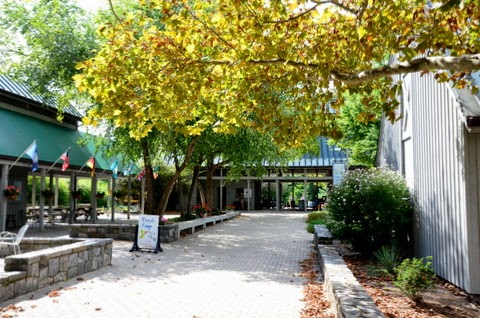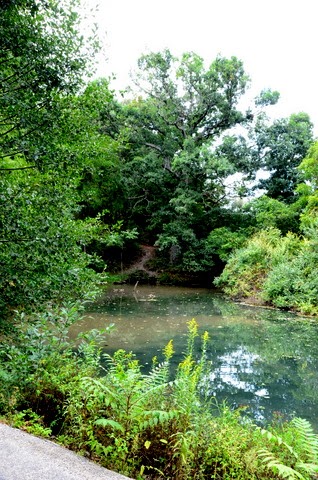For years, as we've driven up and down I-81 on our way to festivals and friends in the South, we've driven past a large roadside sign advertising the Frontier Culture Museum. "I'd like to stop there sometime," I always say, but we've always had "miles to go before we sleep, and promises to keep," as Frost intoned. This year, with a couple of extra days on our way to Dumplin Valley Bluegrass Festival and a Friday evening concert nearby by one of or favorite bands, The Steel Wheels, we finally has a chance to visit this thoughtfully developed and sharply focused living museum in Staunton, VA.
The Main Gate
We like outdoor, living museums. They often succeed in capturing the flavor of a period, a time, a place, a people in ways that exhibits behind glass in more formal museum settings can't quite manage. Places like Mystic Seaport (Mystic, CT), Shelburne Village (Shelburne, VT), The Museum of Appalachia (Norris, TN), and The Farmer's Museum (Cooperstown, NY) all very effectively achieve this goal. The Frontier Culture Museum has bigger fish to fry, and, while still in development, achieves its goal and provided us with an enjoyable and diverting day. The Frontier Culture Museum focuses on the Shenandoah Valley of Virginia seeking to highlight the cultures from which it attracted its inhabitants up to the period just preceding the Civil War and to represent the life these immigrant peoples made for themselves on what was then the frontier of a new and emerging American spirit and nation. In this region, extremely rich in Civil War history, the decision to stop the museum's coverage before the war began seems to be a wise one.
The Welcome Center and Gift Shop
After purchasing our tickets (general admission $10.00) we watched a brief and useful orientation film and headed outside into the museum. The grounds of the Frontier Culture Museum are quite large, and a visit to the museum requires a good deal of walking. Golf carts are available for rental to ease the walk, and shuttles transfer visitors between the two large sections of the grounds. The museum is divided into two major sections. The Old World contains representative farm sites from eighteenth century farms in Africa, Ireland, Germany, and England, representing the major contributors to the life and culture of the Shenandoah Valley into the middle of the nineteenth century. America consists of five buildings showing the progression of living styles from the mid-eighteenth century, when the Valley was truly a frontier, until just before the Civil War, when it was largely settled and increasingly prosperous. Each building has a costumed interpreter engaged in some appropriate task. These interpreters are quite knowledgeable about the dwelling and the period it represents.
The Old World
Africa
Men, women, and children from West Africa were kidnapped and brought to America as slaves with the largest number coming from West Africa in the early to mid-eighteenth century. The African exhibit, the only one not imported from abroad, depicting a 1740's setting, contains several buildings in a compound and a garden with African vegetables which have become staples of the southern American diet, in it.
Yams, Okra, and Gourds in the Garden
The English Farm
A 1600's English farm building shows the life of a working English farmer or some modest substance.
Interpreter Spinning Flax for Linen
The Irish Forge
The Irish Forge is a 1700's building imported from Ulster in northern Ireland. It's the only commercial building presented in the museum. Sadly, the museum lacks representations of commercial enterprises, especially in America. Frontier life undoubtedly offered some village life. Since there is much room for further development, one can only hope that a few shops, perhaps a church or meetinghouse, and a tavern could be added to supplement the wonderful farm buildings already present.
A Blacksmith at Work

The Irish Farm
Linen Weaver at Work
The German Farm
This 1700's German farmstead was a gift to the museum from Germany. the main building was actually still being live in until the 1970's.
After our tour of the Old World, we adjouned to Mrs. Rowe's Family Restaurant, just a mile down the street for a good country lunch. Irene's macaroni and cheese with ham casserole provided her with enough for two meals, and I enjoyed my chicken salad plate. Mrs. Rowe's is well known for it's baked goods, and we each brought a piece of pie home with us.
America
Indian Exhibit
The Indian exhibit captures the essentials of a woods Indian family from the 1730's, just as the European incursion into the Shenandoah Valley began. The mounded garden captures the mixed agriculture typical of Native Americans that the Mayflower expedition found on its arrival in Plymouth in 1620 and which continued until the tribes were driven still further west into the plains and beyond.
1740's American Farm
This farmstead captures the spirit of the humble beginnings experienced by the first settlers arriving in the Valley, many of German origin drifting south from Pennsylvania. The snow on the ground is actually fiber, placed there to represent winter in Valley Forge, for a film being made the day we visited.
1820's American Farm
By the 1820's, life in the Valley had improved, as people streamed through on their way to other places while many others settled here. A large number of the people who came and stayed were of German origin, many Amish and Mennonite, a people whose communities still exist in the region.
Early American Schoolhouse
As civilization spread, so did education. It's hard to completely disguise the incursion of the outside world in this lovely oasis into the past.
1850's American Farm
By the middle of the nineteenth century, conditions continue to improve. This farm family lived somewhat below the prevailing standard of living found as the Civil War loomed just around the corner.
All told, the Frontier Culture Museum effectively captures the worlds from which the population of the Shenandoah Valley was populated and the beginnings of the civilization they built here. Missing, for me, are the rural villages and commercial establishments that had begun to flourish as the nineteenth century progressed. Opened in 1988, the museum is still young. It has lots of open land on which to develop a more comprehensive picture of life during the century between when immigrant people began to settle here and the Civil War. Unfortunately, the recent recession has necessitated cuts in budge which led to staff reductions and the elimination of much of the livestock which originally was on the site. As an agency of the Commonwealth of Virginia, it has access to both private and public funds which could lead to its further development. It can only be hoped that, as economic conditions improve, this invaluable resource will have increased funds with which to continue moving towards the vision which obviously animated its early development. I understand that numerous school, camp, and other groups visit the museum regularly. Our day here was enjoyable, and we'd like to see the museum reach its potential.
How to Reach the Museum: The Frontier Culture Museum is located just west of Exit 222 on Interstate 81 in Staunton, VA. The region is beautiful, and the museum deserves a visit.































No comments:
Post a Comment